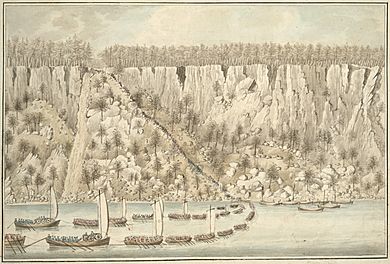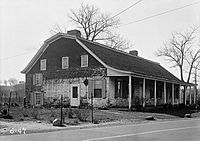New Bridge Landing facts for kids
| Lua error in Module:Location_map at line 420: attempt to index field 'wikibase' (a nil value). |
New Bridge Landing is a very important historical place in New Jersey. It was once a busy village with mills, built around a bridge over the Hackensack River. This bridge was super important during the American Revolution.
On November 20, 1776, General George Washington led his soldiers across this bridge to escape from British forces. It was a crucial moment in the war! Many battles and skirmishes, about eleven in total, happened here during the Revolution. Today, the Draw Bridge at New Bridge was built in 1889 and is a protected historic site. New Bridge Landing is now a New Jersey historic site, covering parts of New Milford, River Edge, Hackensack, and Teaneck in Bergen County.
Contents
A Look Back: The History of New Bridge
New Bridge was first settled by people called the Bergen Dutch. They were farmers who created a unique culture. Their language and traditions mixed ideas from Dutch, African, German, English, French, and Scandinavian settlers.
Early Settlers and the First Mill
The area was originally known as Aschatking, meaning "where the river narrows." In 1682, a Swedish settler named Cornelius Mattyse bought 420 acres here. Later, in 1695, David Ackerman bought this land. His son, Johannes Ackerman, built a house here around 1713.
A special kind of gristmill was built on the Hackensack River. This mill used the ocean's tides for power. When the tide came in, water was trapped in a pond. As the tide went out, the trapped water was slowly released through a waterwheel, making the mill work. Boats called Sloops would come right up to the mill to load and unload goods.
The "New Bridge" is Built
In 1744, a road was planned to the narrow part of the Hackensack River. This is where a "New Bridge" was going to be built. This bridge is now part of Main Street in River Edge.
Jan and Annetje Zabriskie bought the mill and farm in 1745. This was soon after the first draw-bridge was built. It was called "New Bridge" to tell it apart from an older bridge upstream. In 1752, Jan Zabriskie built the oldest part of what is now known as the Steuben House. The Zabriskie family became very rich because of the increased trade during the French and Indian War (1756-1763).
New Bridge Landing: A Busy Center
New Bridge Landing was like the shopping mall of its time for the upper Hackensack Valley. Iron from the Ramapo Mountains was brought here by ox-carts. It was then loaded onto boats and sent to markets. Flour and animal feed were also shipped from the mill. Boats returning from the city brought all sorts of goods.
This location was very important because of the wide Hackensack Meadowlands downstream. New Bridge was the closest river crossing to Newark Bay until 1790. All kinds of travelers, including farmers and stagecoaches, crossed the river here on their way to and from New York City.
The Great Retreat: Washington's Escape
After losing battles like the Battle of Brooklyn, General George Washington and his troops were being chased by the British. On November 16, 1776, Fort Washington in New York fell to the British. Washington then had to leave Fort Lee on the other side of the North River (Hudson River) (which is the Hudson River).

In the early morning of November 20, 1776, a large British and Hessian army, about 5,000 soldiers, crossed the Hudson River. They landed in New Jersey to attack Fort Lee. Washington quickly led his troops in a retreat through Fort Lee, Englewood, and Teaneck. They crossed the Hackensack River at New Bridge. This fast escape saved the American soldiers from being trapped between the Hudson and Hackensack Rivers.
They continued their retreat westward, crossing the Passaic River and taking apart the bridge behind them. Washington continued his retreat through early December, passing through Princeton and Trenton. He eventually crossed the Delaware River into Pennsylvania.
Thomas Paine's Words of Hope
It is believed that Thomas Paine wrote the first part of his famous essays, The American Crisis, in Newark during this difficult time. He supposedly used a drum for a desk and a campfire for light. These essays were meant to encourage American soldiers when things looked bleak. Published on December 19, 1776, just before Washington's victory at Trenton, Paine's words gave people hope. He wrote about the retreat from Fort Lee and crossing the Hackensack River:
Our first goal was to secure the bridge over the Hackensack, which was up the river between the enemy and us... General Washington arrived... and marched at the head of the troops towards the bridge... the greatest part of our troops went over the bridge... We brought off as much baggage as the wagons could hold, the rest was lost. The simple goal was to bring off the soldiers and march them on until they could be made stronger by the Jersey and Pennsylvania militia, so they could make a stand.
The British failed to capture Washington's army at Fort Lee. This was partly because British officers did not realize how important "New Bridge was the key to the peninsula between the Hackensack and the Hudson."
Revolutionary War Events at New Bridge
New Bridge was a constant place for fighting. Here are some important events that happened there:
- On November 21, 1776, British troops attacked the American rear guard and took the New Bridge. American engineers were trying to take it apart.
- British and Loyalist soldiers attacked about 40 local militiamen at New Bridge on May 18, 1779.
- Major Henry Lee led American troops from New Bridge on August 18, 1779. They attacked British defenses at Paulus Hook.
- On March 23, 1780, local militia and Continental troops attacked 600 British and German soldiers. This happened at New Bridge as the British were retreating from Hackensack.
- A group of 312 British, Loyalist, and German soldiers attacked an American outpost at New Bridge on April 15, 1780.
- On May 30, 1780, eight British soldiers were accidentally killed by their own side. This happened when they tried to attack American militia in the Zabriskie-Steuben House.
- Brigadier General Anthony Wayne led American troops from New Bridge on July 20, 1780. They raided a blockhouse at Bull's Ferry.
- General Washington made the Zabriskie-Steuben House his headquarters from September 4–20, 1780. This was during a large encampment of the Continental Army, with nearly 14,000 men.
Historic Homes at New Bridge Landing
On December 23, 1783, the State of New Jersey gave a house, mill, and land to Major-General Friedrich Wilhelm von Steuben. This was a thank you for his great service to the Continental Army. The house had been taken from Jan Zabriskie, who was a Loyalist (someone loyal to Britain) in 1781. This gift was one of many von Steuben received for training the Continental Army. This estate is now known as the Steuben House.
Preserving History
The Steuben House Commission was created in 1926 to buy Baron Steuben's home. New Jersey bought the historic mansion and about 1 acre (4,000 m2) of land for $9,000 on June 27, 1928. After being fixed up, the Steuben House opened as a museum in September 1939. It showed old items belonging to the Bergen County Historical Society. The society also made the Steuben House its headquarters. The Steuben House is listed on the New Jersey and National Register of Historic Places. It is managed by the Historic New Bridge Landing Park Commission.
The Historic New Bridge Landing Park Commission was set up to help protect and share the historic village around New Bridge. This makes sure people can learn from and enjoy the site. Since this historic area is in four different towns (River Edge, New Milford, Teaneck, and Hackensack), the Commission helps everyone work together. The The Bergen County Historical Society, a group of volunteers, is a key part of the commission. They own most of the land and provide all the programs.
The Steuben House is now the main part of a larger historic site. Other old homes that were in danger, like the Campbell-Christie House and the Demarest House Museum, were moved here from New Milford. The Westervelt-Thomas Barn was also moved from Washington Township. These buildings are now safe and preserved. The Bergen County Historical Society also built a working outdoor kitchen.
In April 2007, a big storm called a Nor'easter damaged the Steuben home and the old items inside.
New Bridge Landing Train Station
The New Bridge Landing train station is on the New Jersey Transit Pascack Valley Line. It used to be called North Hackensack. In 2008, it was renamed to honor this important historic site and bring back the old name to the area.
See also


